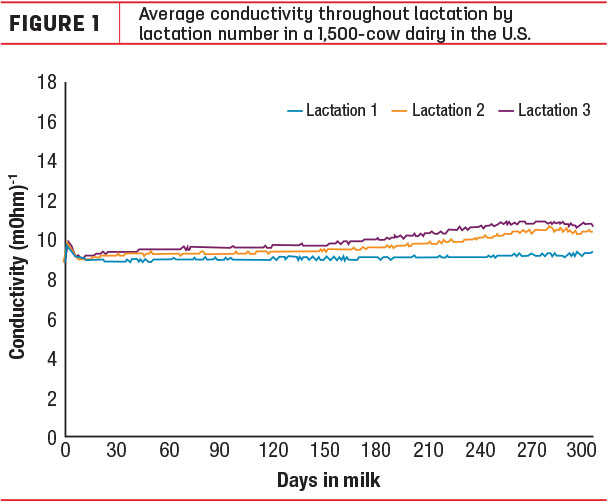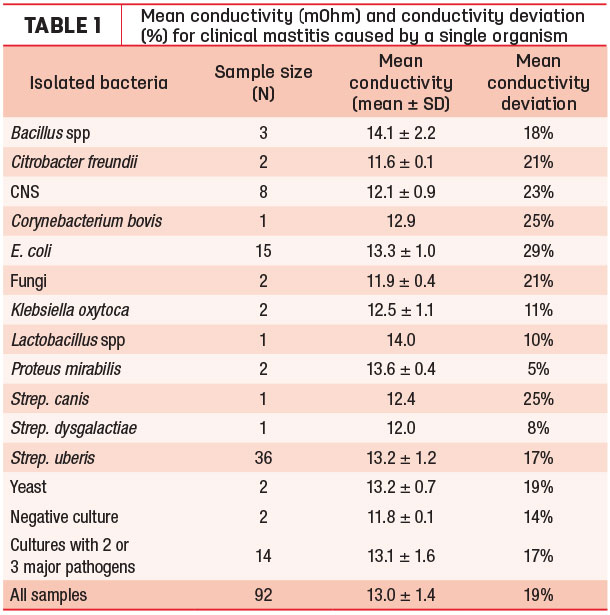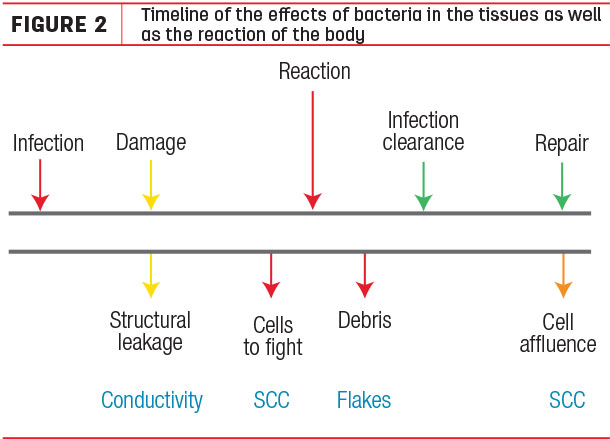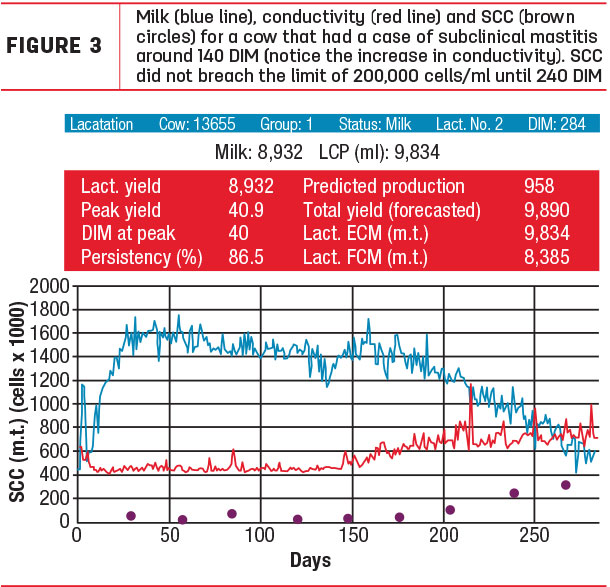Early detection of mastitis cases is considered the best option to allow cows the best chance for a quick recovery. Until now, mastitis detection has been based on seeing clinical signs, such as a swollen quarter or flakes in the milk.
This may prove challenging in large farms that rely on high throughput in the parlor or in cases of subclinical mastitis that don’t show clinical signs yet. New technologies are being tested to automatically detect mastitis in the milking parlor before the cows show clinical signs.
When any kind of damage occurs in the udder, damaged cells release their intracellular contents into the milk, altering the chemical properties of the milk. Two of these properties are the salinity and the lactose content of the milk due to the high intracellular contents of electrolytes.
Salinity can be measured via electrical conductivity, which tests the ability of a material to conduct electricity. The higher the content of salt, the higher the conductivity (measured in megaohms, or mOhm).
Therefore, a quarter with mastitis will show increased conductivity as soon as the cells are damaged and their intracellular content is released into the milk, which occurs before the tissues have had time to react to the damage (Figure 1).
 Mastitis is the inflammation of the mammary tissue. There is a common misconception that mastitis necessarily implies an infectious process (i.e., bacteria). It is important to note that inflammation is not the same as infection.
Mastitis is the inflammation of the mammary tissue. There is a common misconception that mastitis necessarily implies an infectious process (i.e., bacteria). It is important to note that inflammation is not the same as infection.
Consider blunt trauma to one of your fingers; it will get inflamed, but it will not get infected unless the skin is broken, allowing bacteria to colonize the exposed tissue. The same happens with the cow’s udder.
This is likely the reason why 25 to 50 percent of milk samples submitted from cows with mastitis (depending on the farm or study) show no bacterial growth and why many farmers complain about an antibiotic treatment “not always working properly” because there is nothing for an antibiotic to work on.
Because conductivity detects damage to the cells, and not simply reaction to the presence of bacteria, conductivity will increase in the case of inflammation without infection.
The sudden increase in conductivity in Figure 1 the day after calving likely corresponds to the sudden vacuum applied to the udder after several weeks of inactivity (dry period).
Given that there is no infection, this effect is normal and cleared quickly without incident. First-lactation cows maintain steady conductivity throughout the entire lactation, while adult cows increase in conductivity toward the last third of the lactation.
Previous studies on the use of conductivity to diagnose mastitis tend to lean toward an unfavorable opinion, mainly because these studies were trying to find a threshold of conductivity that would determine if cows above the threshold had mastitis and cows below the threshold were healthy.
It can also be due to different milking equipment using different ways to measure or report conductivity, or the fact that some cases of high conductivity were due to inflammation alone and not infection.
Studies that evaluated conductivity as a deviation from the baseline of that animal, or the herd average, found conductivity to be a useful tool to diagnose early mastitis cases and shorten healing time.
Evaluation at the herd level shows that conductivity has a definitive pattern throughout the lactation (Figure 1) and, although the pattern is similar for most farms, the actual conductivity level varies by farm. Not only that, but it varies by lactation number, being higher in adult cows.
Therefore, trying to use a single threshold for every cow in a farm to detect mastitis throughout different days in milk or for different farms is not an effective use of conductivity.
A study at the university teaching dairy in Oregon that had 60 Holstein and 60 Jersey cows showed that both breeds had similar patterns, with no significant differences (P = 0.637): Holstein cows at this farm had on average 9.96 plus or minus 0.32 mOhm, and Jersey cows had 9.97 plus or minus 0.44 mOhm.
Another study conducted at a 1,500-cow commercial farm in Spain, where mastitis was diagnosed using conductivity (Afimilk MPC milk meters) and a milk sample was submitted to a reference laboratory for culture and somatic cell count (SCC) measurement before treatment was taken, showed that the average conductivity for mastitis cases varied between 11.6 and 14.1 mOhms.
This shows the limitations of using a threshold of conductivity to diagnose mastitis. However, independent of the average conductivity, all of the cases had an increase of conductivity, with varying levels of deviation depending on the bacteria involved (Table 1).
 The largest conductivity deviation was observed in cases of E. coli mastitis. In fact, it is possible to use the level of deviation to estimate whether the infection is due to gram-negative or gram-positive bacteria.
The largest conductivity deviation was observed in cases of E. coli mastitis. In fact, it is possible to use the level of deviation to estimate whether the infection is due to gram-negative or gram-positive bacteria.
The comparison of conductivity with SCC showed that there is a lag time between when the damage happens (increase in conductivity) and when the cow reacts to that damage (Figure 2).

This is mostly due to the fact that SCC samples are taken only once every month, while conductivity is measured every cow, every milking, every day.
There is also the caveat that SCC may be high due to prolonged reaction to the cow even though the damage is gone (high SCC in the absence of increased conductivity).
Figure 3 shows a cow with a case of chronic mastitis that can be traced to start around 140 days in milk, while SCC did not increase until approximately 240 days in milk.

This delay of more than three months could make the difference between cure and chronicity in many animals.
Not surprisingly, research in the UK has shown that early diagnosis of mastitis with conductivity can reduce severity (even preventing clinical signs) and shorten time to return milk into the tank by 50 percent (from 30-plus milkings to 17 or fewer, depending on the bacteria involved), reducing overall cost of a case of mastitis.
In the end, this is what drives the decision of whether to use one method or another to diagnose mastitis cases. The earlier we diagnose a mastitis case, the sooner we can intervene and make decisions, promoting better udder health, animal well-being and effective antimicrobial use. ![]()
Aurora Villarroel, DVM, Ph.D., wrote this article while working as the application support manager, Americas West, for Afimilk, Ltd.






